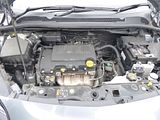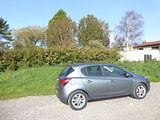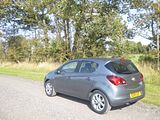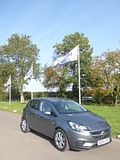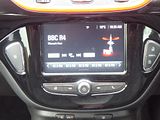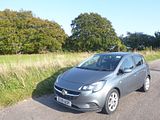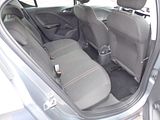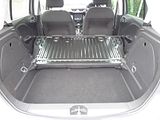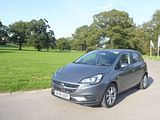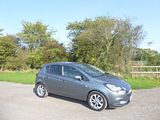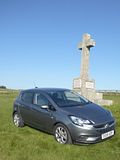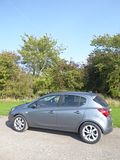The Corsa is an important car for its maker, Vauxhall/Opel, as it constitutes their European best-seller. Perennially popular across mainland Europe, in recent times, there are some months when it has even managed to outsell the Ford Fiesta in the UK, no mean feat given the enduring popularity of Ford’s small hatchback. The car is also popular with the European rental fleets. That makes it all the more surprising that it is many years since I last managed to drive a Corsa, with Hertz tending to focus on other superminis certainly in their UK fleet. The last car I drove was what is sometimes referred to as a Corsa D, the fourth generation of Vauxhall/Opel’s B-segment car, and the one that shared its underlying platform with the Fiat Grande Punto. That car was replaced in the autumn of 2014 by what the press, at the time, called an “all new” Corsa. It did not take more than a quick look at the photos of Corsa E to question that, as the latest model really did look like a somewhat modified version of the old car and gradually it was admitted that this was indeed the case. The changes did go further than new front and back styling, though, with an all-new interior and a thoroughly reworked chassis. At launch, the reviews were quite positive, but it did not take long, and the launch of new versions of the Corsa’s many rivals, for the car quickly to become viewed as something of an also-ran which scored most highly on value, dealers being well known for doing particularly attractive finance deals to keep the sales volumes up. There have been many detailed changes to the car since that 2014 launch, but most of these were focused on meeting the latest emissions and safety standards and tweaking equipment levels. Trying to leapfrog the competition was going to take an all-new car and one of those was under development when parent company GM decided to sell their European business to Peugeot-Citroen. The tough decision was taken to go back to the start and build Corsa F on a PSA (Stellantis) platform, as used by the Peugeot 208 and Citroen C3. In record time, a new model was developed and it was launched at a particularly challenging time just as the world headed into Covid-induced lockdown. So whilst Corsa F has been on the market for a few months now, and some have been sold, the reality is that the previous model Corsa E cars at the ones that still features in the rental fleets, so I needed a car to get me to and from Heathrow for a much-needed Covid-safe break in September 2020, it was a Corsa E that I received. And with rental fleets pruned back to the bare minimum, it was clear when I arrived on site, that it would have been pointless asking for anything else, as this was pretty much all that Hertz had. Anyway, although with its reputation attached to it suggesting this might not be the best car I would drive in 2020, I took the Corsa E, interested to see what I thought.
This generation Corsa has been offered with quite a variety of different engines, petrol and diesel, with launch options in 2014 comprising a mix of that included revised versions of the familiar 1.2 and 1.4 litre petrol units, a new 1.0 litre 3 cylinder with either 90 or 115 PS, a sporty and by all accounts rather unruly VXR with a 205 PS 1.6 litre petrol and a heavily revised version of the established 1.3 litre diesel with 75 or 95PS on offer. All that changed in June 2018 with a model refresh which saw a rationalisation such that all versions of the Corsa E now came solely with versions of Vauxhall’s improved Euro 6.2-compliant 1.4-litre petrol engine – so there was no sign of the diesels or the 1.0, 1.2 or 1.6-litre petrol units that had previously been offered. Buyers now get the choice of either 5 or 6-speed manual gearboxes or an automatic. That 1.4-litre powerplant in normally aspirated form develops either 75 or 90PS, or with a turbo it puts out either 100PS or (in the top GSi) a heady 150PS. Only the turbo gets the 6 speed box and the quote figures suggest that this is actually the most economical model of the range though there is little in it between them all. There’s no badging to tell you which specific model you’ve got so it takes a bit of sleuthing to try to figure it out. It would seem that the test car was a 1.4 litre Sport and it had the least powerful engine tune, just 75 bhp, which when you consider the weight of the car, does not seem a lot. And so it proved. I found it necessary to work the Corsa quite hard to get the best out of it, or even to get decent acceleration, with a quoted 0 – 60 time of 15.5 seconds. So to get the necessary acceleration out of it, you will be using the gears quite a lot. This version of the Corsa gets a 5 speed gearbox, and whilst the actual gear change is good, with the lever slotting cleanly and neatly between ratios, it is set too low and the shape of the knob is a bit awkward. There is 95 lb/ft of torque so the engine does pull well, and once you get beyond 4000 rpm, it feels stronger than it really is, but it also gets quite noisy in the process. Once the Corsa is at a steady cruising speed, noise levels are generally low, with only a little interference from the engine and the road. Generally, this is quite a refined small car and leagues better than you would have experienced only a few years ago. If the 115 bhp is only enough to get reasonable acceleration, though, I have to wonder just how slow the less powerful versions – of which there are several – will feel. I covered 220 miles in the time I had the Corsa, not a lot more than the drive from and to Heathrow with just a short outing for most of the photos that accompany this report. I needed to put 24 litres in it to fill it up, which computes to 41.66 mpg, a reasonable bit not spectacular result. Of course the usual rental car caveat concerns not knowing just how full the car really was when I collected it.
You get the impression that the Corsa has been set up to make it easy to manoeuvre and for city driving. It certainly does not have much in the way of sparkle or fun when out on the open road. Biggest culprit is the steering which is far too light and vague, lacking anything in the way of feel, There is a city button which will make things even worse, or if you are doing lots of three point turns, of course, even easier. Provided you have the confidence of what the steered wheels are doing, then the handling is decent, with plenty of grip and not that much roll but if you are hoping that this car will be as enjoyable to drive as a Fiesta or a Mazda 2 then you are in for a major disappointment. This Corsa came on 195/55 R16 wheels, which are about average for this size of car these days and the suspension is clearly aimed more at comfort than anything else. The associated ride is comfortable enough. Higher spec cars come with slightly lowered suspension, and reports suggest that these do have a penalty in ride quality. There were no issues with the brakes and there is still a conventional pull-up handbrake fitted between the seats. Visibility is OK, with plenty of glass by modern standards, with large side windows and a deep windscreen, and a fairly upright tail, though there are no parking aids on the trim level of the test, like you would find in costlier cars.
One of the most visible changes between this generation Corsa and its predecessor is the all-new dash, following the same sort of style as you will find in the current Astra, which was intended to lift the ambience from the rather evident bargain basement quality reputation the Corsa had built up. And by and large, they’ve succeeded. The plastics are much better quality and there in this trim, there is a leather-wrapped steering wheel and gearlever. Sadly, there is also a rather nasty curvy inlay of particularly horrid quality red plastic, which whilst trying to add some colour contrast to what is otherwise all rather black, almost single handedly undermines all the gains of the rest of the changes. There is a simple instrument cluster under a curved binnacle. There are two large dials for the speedometer and rev counter and two horizontal bar charts for fuel level and water temperature in the upper part of the area between them. Below this are trip computer displays and you can select there by twisting the left hand column stalk. Used in up/down mode, the stalks do indicators and wipers whilst lights operate from a rotary dial on the dash to the right of the wheel. The steering wheel spokes operate the cruise control and audio repeater functions. The 7” infotainment screen, standard on all models, is integrated into the dash but it is set lower than is ideal. On this version, the main functions it offers are for the audio system. There are still plenty of physical buttons to operate this, so you are not forced to use the touch screen interface. Every Vauxhall Corsa comes with Apple CarPlay and Android Auto smartphone mirroring as standard so you can use your phone’s navigation apps through the car’s built-in screen instead, which is just as well, as navigation is a cost option on all models. These features also let you make calls and stream music from your phone through the car’s stereo – just don’t expect the sound quality to be particularly impressive. All cars come with a six-speaker stereo system with DAB digital radio and Bluetooth connectivity but there’s no option to upgrade to a big-name brand unlike some rivals. Depending on the display you are projecting, the clock which is also on the main screen may suddenly be obscured by the driver’s left hand. The rotary dials for the climate control are below this and again, are lower set than is ideal. Included on all versions of the Corsa these days is a heated screen. Overall, the set of minor controls are neatly presented and easy to use.
Seat upholstery is all cloth and is the sort of quality you get these days which is really not that nice. There’s a stippled pattern to the main part of the seat and some red and white striping up the middle and red stitching on the outer edges which do also lighten the ambience a bit from all the rest of the black. With pronounced bolstering, the seats in the Sport version are intended to be a bit more sporty in style than you get in the lesser trimmed cars, but sadly I just found them to be not that comfortable. They are fully adjustable, manually, of course, in all the obvious ways with a height adjuster for the driver. Even the very top of the range cars lack this for the passenger and none of the versions have lumbar support, either, which is a bit surprising. The steering column telescopes in/out as well as up/down, so at least I could get a comfortable driving position, and unlike some previous generation Corsa models, that position is not particularly offset like it used to be.
The rear seats provide decent space for two adults, with just about enough legroom even if the front seats are set well back. Getting three in here would be very tight. Headroom is not an issue, with slightly more on offer than there is in the three door cars. Access is also easier with the five door body. The headrests are set very low, so you will need to pull them well up, which the driver may object to as this impairs rear visibility somewhat. The angle of the backrest can be varied through a few degrees. There are no map pockets here, but the door bins are useful and there is a single cupholder. Rear windows are operated manually.
The boot is only modest in size. It is narrower than you will find in some cars, with the sides closed off so they are flush with the wheelarches, but it is quite deep, though this does mean that the boot floor is quite a bit lower than the base of the tailgate. There is some space for bits and pieces under the boot floor, largely as there is no spare wheel there. The rear seat backrest is in a single piece, and simply drops down onto the seat cushion. The result is a much bigger load area but it is not flat. However, you can fix that by specifying the adjustable boot floor, which will set you back £142 but it makes loading very heavy items much easier and means you can hide a few soft bags away underneath. Even in its raised position there’s enough room left in the boot for a baby buggy or a couple of suitcases. Inside the cabin, there is a modestly-sized glovebox but the pockets on the doors are larger than you get in a lot of cars, each able to hold a couple of large bottles. There is a cupholder area in front of the gearlever, but that is it for odds and ends.
There have been a bewildering array of different Corsa E models offered since launch and there’s no easy way simply t describe the entirety of them. The last significant change to the car came in the summer of 2018 when updates included changes to meet Euro 6.2 emissions standards. Available in three or five door variants, the range introduced the new chain cam 1.4-litre Euro 6.2 compliant petrol engines. Paired with either a five or six speed manual, or automatic transmission, the new engines could achieve up to 50.4mpg and CO 2 emissions as low as 128g/km. all other engines were deleted from the range. From that point, the Corsa range was available in seven different trim levels, most of them with a choice of the three or five door body, with prices starting from just £11,250 on-the-road for the entry-level Active model. Customers can also choose from Design, Energy, Sport, SRi Nav, SE Nav and SRi VX Nav Black models and there was more tech added as standard on selected trims. The refreshed Corsa introduced air conditioning as standard starting from the Design trim, and Navi 4.0 IntelliLink touchscreen navigation and infotainment system on all models from the SRi Nav trim. With that many different versions, it is perhaps not a surprise to learn that the differences between the trim and equipment levels are quite small, though be aware that the entry level Active spec will look just that – entry level, or really quite mean. Pick a Design car or above and you’ll get a height adjuster for the driver’s seat, a leather-trimmed steering wheel and DAB digital radio while mid-range SE versions get more supportive heated front seats and a heated steering wheel. Top-spec Elite cars sport some extra-plush velour floor mats and tinted windows as standard. SE and Elite cars get parking sensors as standard. Other key differences as you head the range are as follows: The entry-level Active model, which is only available in three-door form, has 15in alloy wheels, cruise control and a heated windscreen. Move up to Design and not only can you choose from three or five-door body styles but you get air conditioning, front foglights and a touchscreen display. Strangely, though, the wheels are steel rather than alloy. The next trim, Energy, sees the return of alloy wheels, this time 16in rather than the 15in affairs fitted to Active trim. Sport adds sporty front seats, alloy-effect pedals, a leather-covered steering wheel and dark tinted windows. As its name suggests, SE Nav has a sat nav and is just that little bit more comfort-oriented than Sport. Both are around the same price. SE Nav trim buyers can now specify an optional Lux pack which, for £1,500, brings features including special 17in alloy wheels, a rearview camera, tinted rear windows and single zone climate control. SRi Nav is a blend of Sport and SE Nav, with a price to match. SRi VX-Line Nav Black is more eye-catching still with elements of the old VXR (rear spoiler, 17in alloys and a body kit). However, it’s only available with the 75 or 90PS engines so performance-wise doesn’t live up to its visual promise. It was always viewed as very expensive for a car that was relatively all show and not that much go. The go factor was restored a few weeks after the arrival of the main range, when a new 150 bhp GSi model arrived, based on the short-lived and somewhat unruly previous VXR though with less power. Not that many were sold as most customers focused on the cheaper models in the range.
My expectations for this Corsa were pretty low. I had read too many reports that were dismissive of the car in all respects bar its value for my pre-conceptions not to be affected. The reality was that I found a car that was better than I was expecting. Unlike the truly dreadful Mokka, which I really struggle to like at all, or the little-better Crossland, this Corsa was perfectly acceptable. I can quite see why if there is a local dealer and they come up with an attractive finance deal, you would sign on the dotted line. For urban motoring this car will meet your needs, prove easy to drive, and with no serious weaknesses likely to be that evident. But if you’ve had the chance to drive one of the extensive list of rivals, such as the Ford Fiesta, or Skoda Fabia, Mazda 2 or Renault Clio, then I think you would quickly conclude that there are cars that are more engaging to drive and for anyone who values this, then they should all really get priority over a Corsa E. Everything I’ve read suggests that Corsa F is a very different proposition, and so I have to hope that I get to sample one of those sooner rather than later.































































